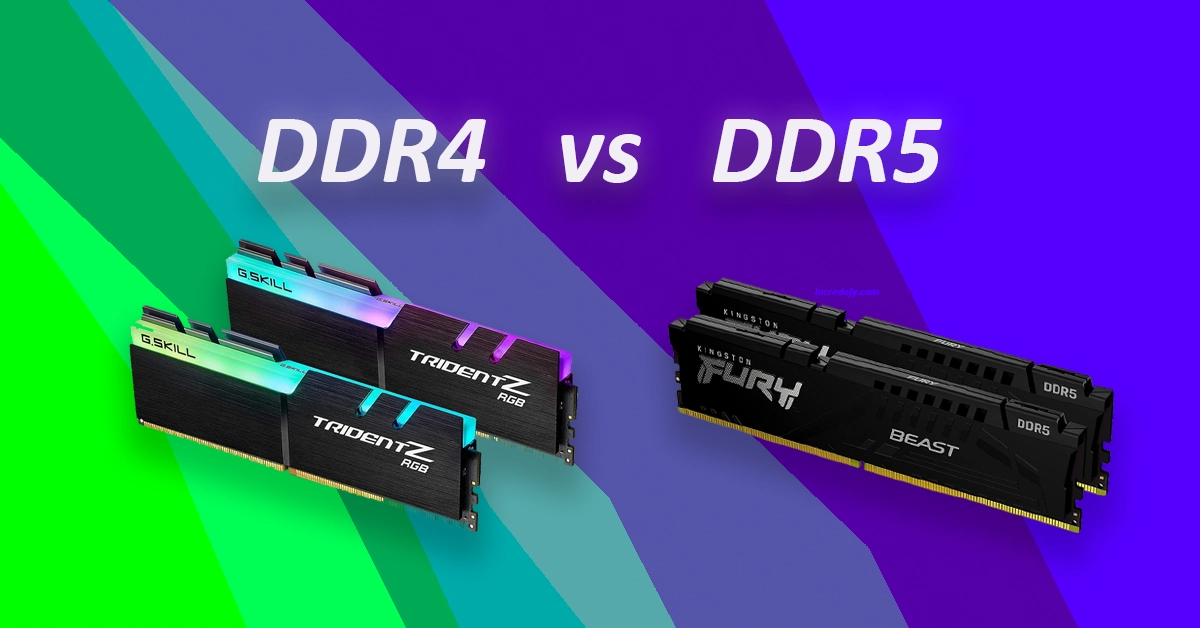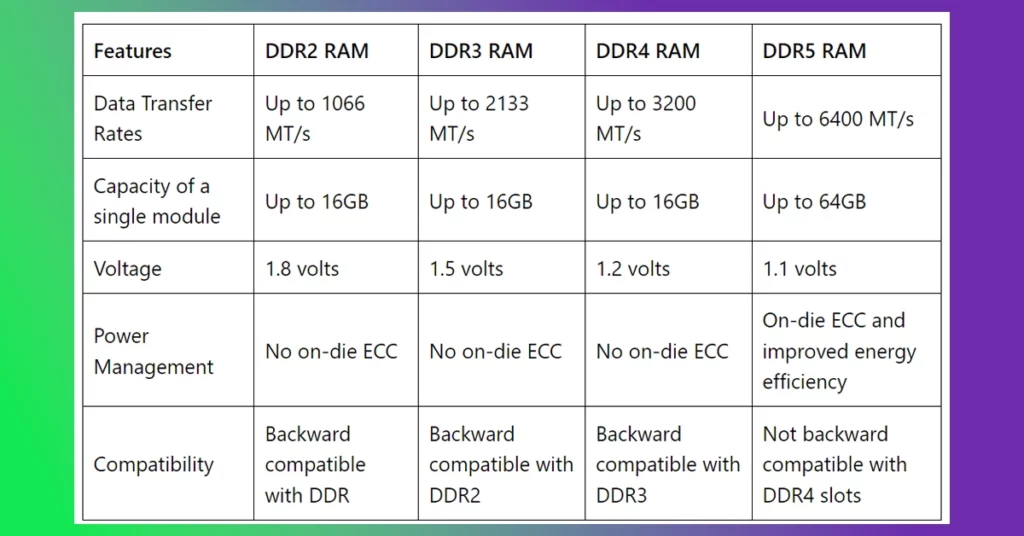
DDR4 vs DDR5 RAM: Comparing the Costs and Benefits for your PC
Snehil
- 0
Building a PC is never easy and choosing a component is not just about the value it offers. To make a wise, future-proof decision or cost-cutting decision, you must know the repercussions of choosing the wrong motherboard, or about to be obsolete socket etc.
Ensuring our readers get the best knowledge before purchase, we have made a comprehensive guide to RAM (memory), and this guide is not just about plain recommendation. Instead, we will discuss all the technical aspects of the tech, the past versions and the future versions. This guide will be updated in the future, as will our other posts, keeping the guide actually useful.
Table of Contents
DDR4 vs DDR5 RAM: What’s the Difference?
DDR4 and DDR5 are two of the most widely used types of DDR RAM in modern computers. DDR4 RAM was first introduced in 2014 and has been the standard for several years, while DDR5 RAM is the latest iteration and was first released in 2021.
DDR4 RAM operates at a voltage of 1.2 volts and has a maximum data transfer rate of 3200 MT/s. DDR5 RAM, on the other hand, operates at a voltage of 1.1 volts and has a maximum data transfer rate of 6400 MT/s. This means that DDR5 RAM has the potential to transfer data at a much faster rate than DDR4 RAM.
In addition to the differences in voltage and data transfer rate, DDR5 RAM also has several other advantages over DDR4 RAM. For example, DDR5 RAM uses an on-die ECC (Error-Correcting Code) that enables it to correct errors in real-time, thereby improving reliability and reducing the risk of data loss or corruption. DDR5 RAM also uses a more advanced power management system that enables it to consume less power than DDR4 RAM, which can help to reduce overall system power consumption and improve battery life in mobile devices.
Despite the many advantages of DDR5 RAM, there are also some potential drawbacks that users should be aware of. For example, DDR5 RAM is currently more expensive than DDR4 RAM, which could be a barrier to adoption for some users. Additionally, not all motherboards and CPUs are compatible with DDR5 RAM, so users may need to upgrade their entire system in order to take advantage of the benefits of this new technology. For example, Intel’s 12th and 13th Gen CPUs support both DDR4 and DDR5 RAM, whereas AMD’s new range of processors only support DDR5 RAM.
Brief history of DDR RAM technology
DDR (Double Data Rate) RAM technology has evolved significantly over the years, with several iterations being released since its inception. DDR RAM was first introduced in 2000, and it enabled data to be transferred twice per clock cycle, thereby doubling the data transfer rate of the memory. This was followed by DDR2 RAM in 2003, which offered higher data transfer rates and lower power consumption than DDR RAM.
In 2007, DDR3 RAM was released, which offered even higher data transfer rates and lower power consumption than DDR2 RAM. DDR3 became the standard for several years, until DDR4 RAM was introduced in 2014. DDR4 RAM offered significant improvements over DDR3 in terms of speed, power consumption, and capacity.
Most recently, DDR5 RAM was released in 2021, offering even faster data transfer rates and improved power consumption compared to DDR4. DDR5 RAM also includes several new features, such as on-die ECC and improved power management, that make it a more advanced and reliable option for high-performance computing. DDR5X with speeds upto 7200 MT/s is already in the works and is expected to arrive next year.

Importance of RAM in computer performance
While most of us focus most on the CPU and GPU, one of the most underrated components is the RAM. Interestingly, if you have an integrated GPU, it uses the RAM itself. So, it’s important to make sure that if you want the best performance of your dedicated GPU like Intel EVO or Vega integrated graphics, you should have enough memory, preferably above 16GB and most importantly a faster RAM. Dedicated GPUs have their own memory.
RAM is an essential component in modern computer systems, and faster versions of RAM are becoming increasingly important for optimal performance. This is particularly true for demanding tasks such as gaming, video editing, and 3D modeling. For example, the latest AAA video games often require high amounts of RAM to run smoothly, with some titles recommending 16GB or more. This is because the game’s assets, such as textures and models, need to be loaded into RAM to be accessed quickly by the CPU and GPU. Without sufficient RAM, the game may need to rely on slower forms of storage, such as the hard drive or solid-state drive, which can result in longer load times and lower frame rates.
Similarly, video editing software, such as Adobe Premiere Pro or DaVinci Resolve, also benefits from faster RAM. When editing high-resolution video footage, the software needs to load the video files into RAM for processing. With faster RAM, the software can access and transfer the data more quickly, resulting in faster render times and a more efficient workflow.
In addition, some new software applications are specifically designed to take advantage of faster RAM. For example, machine learning algorithms and AI applications, like Stable Diffusion, which run natively on the PC require large amounts of data to be processed quickly, which can be achieved with faster RAM.
DDR4 vs DDR5 Gaming comparison
DDR5 RAM boasts a number of technical advancements over DDR4, including double the bandwidth and density and reduced power consumption. This increased bandwidth allows for faster processing of memory-intensive applications, including gaming, video and image editing, 3D modeling, and web browsing. The higher rate at which DDR5 can access memory also makes it better suited for gaming from a technical standpoint.
However, in real-world scenarios, the performance difference between DDR4 and DDR5 may not be as significant as the technical specifications suggest. The performance benefits of DDR5 are typically only noticeable when using high-end CPUs and GPUs, as well as when running memory-intensive games such as Assassin’s Creed Valhalla, Cyberpunk 2077, and Red Dead Redemption.
In testing the performance of DDR4 and DDR5 memory, it was found that DDR5 offers some performance improvement, but not enough to justify the extra cost of upgrading. DDR4 3600 performs similarly to DDR5 5200, so it’s better to save money by going for DDR4 and invest in a better graphics card instead. Value is important in building a gaming PC, and spending too much on memory is not worth it when there are other factors at play. Overclocking via XMP profile is helpful for extra performance, but don’t spend too much time on it. Ultimately, the takeaway is that DDR5 is not a game-changer and DDR4 is still a viable option for a gaming PC.
DDR4 vs DDR5 RAM in Professional Use
There are a few reasons why professionals might prefer DDR5 RAM for tasks such as video editing, designing graphics, and using heavy applications like DaVinci Resolve, Premiere Pro, Blender, and others. Firstly, DDR5 RAM offers higher bandwidth, which can result in faster data transfer speeds and overall improved performance. This can be particularly beneficial when working with large files or running multiple applications simultaneously, as it allows for quicker access to data and faster processing times.
Additionally, DDR5 RAM typically has higher memory capacity than DDR4, allowing for more data to be stored and accessed at once. This can be particularly useful for professionals working with large files or running multiple applications simultaneously, as it allows for smoother and more efficient workflow.
Finally, while DDR5 RAM may be more expensive than DDR4 currently, it is important to consider the long-term benefits and potential cost savings. As more applications and software are developed to take advantage of the higher bandwidth and increased memory capacity of DDR5, professionals may find that the investment in DDR5 RAM pays off in terms of improved productivity and reduced hardware upgrade costs in the future.
Motherboard and Processor Support for DDR4 vs DDR5
DDR4 supported processors and motherboard
DDR4 RAM is currently supported by most modern motherboards and processors. Intel CPUs supporting DDR4 include the 6th generation (Skylake) and newer processors, while AMD CPUs supporting DDR4 include the AM4 and TR4 platforms. Most DDR4 motherboards have four memory slots, allowing for a maximum of 64GB of RAM.
Sockets supporting DDR4 RAM include LGA 1151, LGA 1200, LGA 2066, AM4. While processors that still support DDR4 RAM include 6th-13th Gen Intel Core, AMD Ryzen, AMD Ryzen Threadripper, and AMD EPYC. However, the maximum frequency of RAM can vary depending on the motherboard.
DDR5 supported processors and motherboard
DDR5 RAM is a newer technology and is not yet widely supported by motherboards and processors. As of now, the new Intel Alder Lake CPUs and some AMD CPUs support DDR5. DDR5 motherboards typically have two memory slots, allowing for a maximum of 32GB of RAM.
However, as DDR5 becomes more prevalent in the market, it is likely that more processors and motherboards will support it. Currently, Sockets supporting DDR5 RAM are LGA 1700, and AM5. Processors supporting DDR5 RAM include 12th Gen, 13th Gen Intel Core, AMD Ryzen 7000 series CPUs
AMD’s AM5 platform only supports DDR5 memory, simplifying things in the long run, while Intel’s 12th and 13th gen processors give choice of both DDR4 and DDR5. Intel will come with new LGA 1851 socket this year, shedding DDR4 support. While AMD, which has just transitioned to the new AM5 socket, has plans to support DDR5 through 2025. Although AMD Ryzen 7000 desktop processors offer support for DDR5-5200 for a 1 DIMM per channel configuration, using 2 DIMMs per channel comes with a penalty, reducing the maximum JEDEC speed to DDR5-3600. System builders need to consider memory expansion carefully, and for peak performance, it’s best to treat Ryzen 7000 as a 1 DIMM per channel platform.
Conclusion
DDR5 RAM has several key differences compared to DDR4 RAM. The speed of DDR5 RAM is significantly faster, with top speeds currently at 4800MHz, compared to DDR4’s top speed of 3200MHz. DDR5 RAM also has twice the bandwidth of DDR4, allowing for faster data transfer between the CPU and RAM. Additionally, DDR5 RAM operates at a lower voltage, which can result in reduced power consumption and heat generation.
DDR5 RAM also has lower latency compared to DDR4, which means that it can access data faster. However, DDR5 RAM is not backward compatible with DDR4, and a motherboard that supports DDR5 is required to use this newer RAM technology. As for cost, DDR5 RAM is currently more expensive than DDR4 RAM, but as the technology becomes more widespread, the prices are expected to drop.
Overall, DDR5 RAM offers several significant improvements in speed, bandwidth, power consumption, and latency compared to DDR4 RAM. While the technology is still relatively new, it is expected to become more widely adopted in the coming years as prices drop and more motherboards support DDR5 RAM.
Best RAM modules for PCs in 2023
Some top-performing DDR5 RAM options available in the current market:
Corsair Vengeance DDR5-4800MHz: This RAM boasts a speed of 4,800MHz, which is comparable to some of the high-end DDR4 RAM from the previous generation. However, the efficiency of DDR5 RAM is notably higher due to its dual channels and compact size.
XPG Lancer DDR5: These memory sticks are ideal for overclocking and come with support for Intel XMP 3.0 for easy performance tuning. With a CAS latency of 38, it is one of the lowest in the DDR5 space thus far.
Some of the top DDR4 RAMs available in the current market:
Corsair Vengeance RGB: This is considered one of the best DDR4 RAMs on the market, with a speed of 3,200MHz and a sleek RGB lighting feature.
OLOy Owl: This budget-friendly DDR4 RAM has a speed of 3,200MHz and comes with a lifetime warranty.
HyperX Predator DDR4 RGB: Another top-performing DDR4 RAM, it has a speed of 3,200MHz and comes with RGB lighting.
FAQs
What is the difference between DDR4 and DDR5 RAM?
DDR5 RAM has a higher bandwidth and faster transfer rates compared to DDR4 RAM. DDR5 RAM also consumes less power and supports higher capacities.
What are some advantages and disadvantages of DDR5 RAM and DDR4 RAM?
Advantages of DDR5 RAM include faster speeds, better power efficiency, and higher capacities. Disadvantages include higher costs and the need for updated hardware to support it.
What is the brief history of DDR RAM technology?
DDR RAM technology has evolved over the years, with DDR1 being released in 2000, followed by DDR2 in 2003, DDR3 in 2007, DDR4 in 2014, and DDR5 in 2020.
Why is RAM important for computer performance?
RAM is important for computer performance because it serves as temporary storage for data that the CPU needs to access quickly. The more RAM a computer has, the more applications and programs it can run simultaneously, leading to faster and smoother performance.


